|
Toward the end of the eighteenth century, just about the time the revolution slowed down organ-building in France for a few years, the organs that were being built used higher wind pressures than they had before, and the sound of individual stops (especially the reeds) was much bolder than anything you would have found a hundred years before. The musical trend toward louder instruments continued in the early nineteenth century, and organs needed to have individual sounds that were possible only with higher wind pressures. When Cavaillé-Coll was building his first major organ in the region around Paris (at the Basilica of St. Denis), he ran into trouble. It took too much force to press down a key, because the mechanical action had to overcome the resistance generated by large amounts of wind, and the sounds he wanted needed the wind.
Cavaillé-Coll solved the problem by adapting something that had been invented by Charles Spackman Barker, an Englishman who had made several devices to improve the mechanical workings of organs. The specific device adapted by Cavaillé-Coll used the wind pressure of the organ to assist in opening the pallets that allowed wind to enter the pipes. Today this device is sometimes called a "Barker lever," or sometimes -- when a lot of the levers are used together, as they usually are -- a "Barker machine." Today, this use of his name is about the only way we remember the man who invented a device that is part and parcel of the Cavaillé-Coll organ.
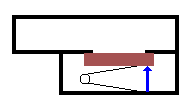 It will probably help to understand what the Barker lever does if you remember how a pallet and slider chest works.181 The relevant fact here is that there are two forces that keep a pallet closed when the key is not pressed: It will probably help to understand what the Barker lever does if you remember how a pallet and slider chest works.181 The relevant fact here is that there are two forces that keep a pallet closed when the key is not pressed:
- The small spring -- the black squiggly shape just below the brownish rectangle in the diagram to the right. It looks something like a deformed paper clip, or maybe a pair of calipers seen from the side. It's made of a metal, and when you try to press on the ends of the "legs," they resist and try to push back -- if you don't mind a little personification here. In this case, the legs of the spring are trying to spread out a little, so they're holding the brown rectangle up against the top of the "box."
- Wind pressure, indicated by the blue arrow in the diagram. When the organ is "on," the box that contains the spring is filled with air under pressure, and this pressure is an added force that the player must overcome in order to open the pallet and play a note.
Two conditions will make it difficult to open the pallet without a lot of pressure from the key.
- If the wind pressure is high, more force is required in two ways.
- More force is needed to overcome the pressure initially, so that the pallet can be opened.
- A stronger spring is needed to close the pallet against the wind after it has been opened. This means that the initial force must overcome both the high wind pressure and the stronger spring.
- The size of the pallet itself has an effect on the force required to move the key. As you might expect, larger pallets mean that there is more surface for the wind to act on, so even more force is required to open the pallet.
- Large organs require more wind to feed many pipes, and larger pallets are required.
- Pipes that are voiced on high pressure need more wind, so pallets must be larger.
- Large pipes - - many 8' stops on a single division, for example - - need more wind, so larger pallets are required.
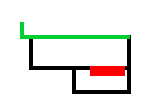 The diagram to the left shows a very simplified version of a single Barker lever. It looks like a diagram of a pallet box and key channel doesn't it? In effect, that's what it really is, but the top of the channel (green in the diagram) doesn't have toeholes, but is simply a hinged bellows. If you move your mouse pointer over the diagram, you will see how the bellows opens when the pallet (red) is opened. Wind, represented by the blue arrow, raises the top of the bellows, and when the wind is shut off as the pallet closes, the bellows collapses. Of course this diagram is very simple, and there are some other components - - such as a way to vent the excess wind when the pallet closes, but a Barker lever basically does this one thing: it raises the top of the bellows. The diagram to the left shows a very simplified version of a single Barker lever. It looks like a diagram of a pallet box and key channel doesn't it? In effect, that's what it really is, but the top of the channel (green in the diagram) doesn't have toeholes, but is simply a hinged bellows. If you move your mouse pointer over the diagram, you will see how the bellows opens when the pallet (red) is opened. Wind, represented by the blue arrow, raises the top of the bellows, and when the wind is shut off as the pallet closes, the bellows collapses. Of course this diagram is very simple, and there are some other components - - such as a way to vent the excess wind when the pallet closes, but a Barker lever basically does this one thing: it raises the top of the bellows.
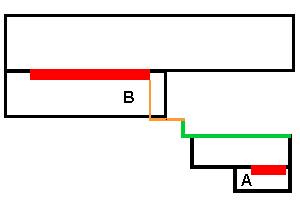 The diagram to the right shows what appears to be two pallet boxes with red pallets. The one marked "A" is a Barker lever, and it is attached to the larger one (marked "B"), which leads to a key channel. Imagine that the key is attached to the small pallet of the Barker lever; relatively little force would be required to move such a small pallet. Now move your mouse pointer over the diagram. You can see that as the smaller pallet of the Barker lever opens, it in turn opens the larger pallet leading to the key channel. The bellows at the top of the Barker lever has enough force behind it to open the larger pallet. The diagram to the right shows what appears to be two pallet boxes with red pallets. The one marked "A" is a Barker lever, and it is attached to the larger one (marked "B"), which leads to a key channel. Imagine that the key is attached to the small pallet of the Barker lever; relatively little force would be required to move such a small pallet. Now move your mouse pointer over the diagram. You can see that as the smaller pallet of the Barker lever opens, it in turn opens the larger pallet leading to the key channel. The bellows at the top of the Barker lever has enough force behind it to open the larger pallet.
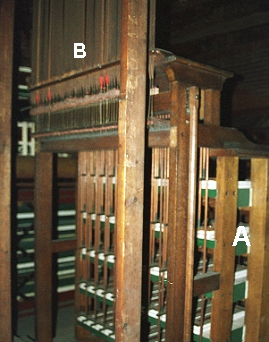 The diagram shows the two pallet boxes relatively close together, but it is not necessary that they be next to one another at all. In actual practice, Cavaillé-Coll placed a set of Barker levers (making up a "machine") together in a space below a chest. Then a series of trackers, rollers and squares transmitted the action of the lever to the pallet box. The photograph to the left shows one of the machines Cavaillé-Coll built for the organ at St. Sulpice. The green and white shapes partly hidden by support structures (marked "A") are the Barker levers, neatly arranged in a compact stack. The trackers at point "B" lead to a roller board and the chest above. The diagram shows the two pallet boxes relatively close together, but it is not necessary that they be next to one another at all. In actual practice, Cavaillé-Coll placed a set of Barker levers (making up a "machine") together in a space below a chest. Then a series of trackers, rollers and squares transmitted the action of the lever to the pallet box. The photograph to the left shows one of the machines Cavaillé-Coll built for the organ at St. Sulpice. The green and white shapes partly hidden by support structures (marked "A") are the Barker levers, neatly arranged in a compact stack. The trackers at point "B" lead to a roller board and the chest above.
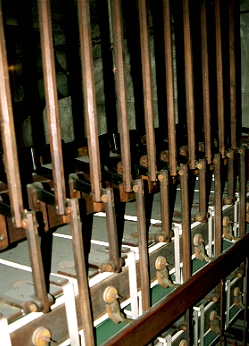 As adapted and improved by Cavaillé-Coll, the principle of the Barker machine could be used for purposes other than making the key action lighter. The photograph to the right, also of a part of the organ at St. Sulpice, shows another Barker machine. You can see that the rods attached to the bellows are heavier than a normal key tracker. In this instance, the Barker levers are used to move stop controls, and a second system of rods and trundles carries the force of the lever to the sliders in the chests above the Barker machine. Using the Barker machine for the stop mechanism meant that Cavaillé-Coll could build additional controls that allowed the player to change stops quickly while he or she was actually playing the organ. It gave the player even more flexibility than was possible with the ventil system explained on another page of this tutorial. As adapted and improved by Cavaillé-Coll, the principle of the Barker machine could be used for purposes other than making the key action lighter. The photograph to the right, also of a part of the organ at St. Sulpice, shows another Barker machine. You can see that the rods attached to the bellows are heavier than a normal key tracker. In this instance, the Barker levers are used to move stop controls, and a second system of rods and trundles carries the force of the lever to the sliders in the chests above the Barker machine. Using the Barker machine for the stop mechanism meant that Cavaillé-Coll could build additional controls that allowed the player to change stops quickly while he or she was actually playing the organ. It gave the player even more flexibility than was possible with the ventil system explained on another page of this tutorial.
|

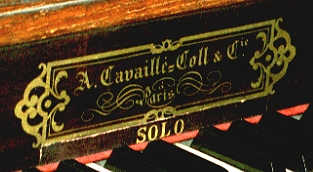
 It will probably help to understand what the Barker lever does if you remember how a pallet and slider chest works.
It will probably help to understand what the Barker lever does if you remember how a pallet and slider chest works.

 The diagram shows the two pallet boxes relatively close together, but it is not necessary that they be next to one another at all. In actual practice, Cavaillé-Coll placed a set of Barker levers (making up a "machine") together in a space below a chest. Then a series of
The diagram shows the two pallet boxes relatively close together, but it is not necessary that they be next to one another at all. In actual practice, Cavaillé-Coll placed a set of Barker levers (making up a "machine") together in a space below a chest. Then a series of  As adapted and improved by Cavaillé-Coll, the principle of the Barker machine could be used for purposes other than making the key action lighter. The photograph to the right, also of a part of the organ at St. Sulpice, shows another Barker machine. You can see that the rods attached to the bellows are heavier than a normal key tracker. In this instance, the Barker levers are used to move stop controls, and a second system of rods and trundles carries the force of the lever to the sliders in the chests above the Barker machine. Using the Barker machine for the stop mechanism meant that Cavaillé-Coll could build additional controls that allowed the player to change stops quickly while he or she was actually playing the organ. It gave the player even more flexibility than was possible with the ventil system explained on another page of this tutorial.
As adapted and improved by Cavaillé-Coll, the principle of the Barker machine could be used for purposes other than making the key action lighter. The photograph to the right, also of a part of the organ at St. Sulpice, shows another Barker machine. You can see that the rods attached to the bellows are heavier than a normal key tracker. In this instance, the Barker levers are used to move stop controls, and a second system of rods and trundles carries the force of the lever to the sliders in the chests above the Barker machine. Using the Barker machine for the stop mechanism meant that Cavaillé-Coll could build additional controls that allowed the player to change stops quickly while he or she was actually playing the organ. It gave the player even more flexibility than was possible with the ventil system explained on another page of this tutorial.